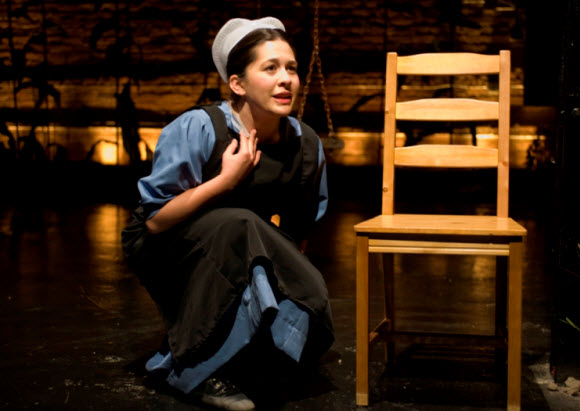Role Playing: Sadieh Rifai zips among seven characters in one-woman ‘Amish Project’
Interview: Switching from an Amish school girl to a distraught widow to a troubled killer, Sadieh Rifai portrayed the entire cast of Jessica Dickey’s “The Amish Project” at American Theater Company.
By Lawrence B. Johnson
Sadieh Rifai thought Jessica’s Dickey’s play “The Amish Project,” which closed Oct. 30 at American Theater Company, would be a pretty straight-forward one-woman show. The young actor would be switching among seven characters, but she didn’t see that as a big deal. She was in for a big surprise.
 Audiences transfixed by Rifai’s multi-strand narrative, about one troubled man’s murderous assault on a group of Amish school girls in 2006, are witnessing a theatrical tour de force. They might never guess just how challenging the project proved to be. They aren’t supposed to. That’s what makes Rifai’s performance so remarkable.
Audiences transfixed by Rifai’s multi-strand narrative, about one troubled man’s murderous assault on a group of Amish school girls in 2006, are witnessing a theatrical tour de force. They might never guess just how challenging the project proved to be. They aren’t supposed to. That’s what makes Rifai’s performance so remarkable.
“It’s the hardest thing I’ve ever worked on, and the most rewarding,” said Rifai, who trained in theater at Southern Illinois University and Illinois State University before becoming a member of the ATC ensemble in 2008. “When you’re on stage with another actor, you can look at them and use their emotion to guide your next line. That fuels you as an actor. When you’re on stage by yourself, and you’re playing multiple characters, each of them on a different narrative arc, the switching has your mind racing a million miles a minute. Where did I leave that character, what was their last line?”
In “The Amish Project,” Rifai portrays a little girl, her older sister, the widow of the killer, a teenage Puerto Rican girl who lives in this Pennsylvania community, a non-Amish woman outraged by the massacre, a non-Amish scholar of Amish culture and the killer, Charles Roberts, a milk truck driver whose route included the village of Nickel Mines, PA.
 On Oct. 2, 2006, Roberts entered an Amish schoolhouse in Nickel Mines, ordered the teacher and all the boys out at gun point, then bound and shot 10 little girls, killing five of them, before taking his own life. The Amish community’s reaction was a collective expression of immediate forgiveness, extended personally to the gunman’s widow, Carol Roberts. The play deals with this gesture of grace, the stunned widow’s difficulty in accepting it and perspectives on the incident from the viewpoints of two Amish girls and non-Amish townspeople.
On Oct. 2, 2006, Roberts entered an Amish schoolhouse in Nickel Mines, ordered the teacher and all the boys out at gun point, then bound and shot 10 little girls, killing five of them, before taking his own life. The Amish community’s reaction was a collective expression of immediate forgiveness, extended personally to the gunman’s widow, Carol Roberts. The play deals with this gesture of grace, the stunned widow’s difficulty in accepting it and perspectives on the incident from the viewpoints of two Amish girls and non-Amish townspeople.
Of all the characters, says Rifai, she enjoys most playing the one we see first, the younger Amish child Velda.
“I used to be a Nanny, and I’m the oldest of seven kids, so I’ve been around kids constantly,” she said. “Once I decided to do this play, really began to notice things about children, the way they move, how they can suddenly become loud for no reason (she laughs), the way they use their voices to get attention – and how everything they see or do is the most important.”
From Velda, Rifai modulates into her older sister Anna, with a distinct change of bearing, facial expression and even language: “I go to more of a Pennsylvania Dutch accent so the audience can see plainly that it’s a new character speaking.” She said director PJ Paparelli, who is also ATC’s artistic director, wanted to make the early transitions deliberate and clear – because the changes pick up speed like an el train moving out of the station, until Rifai is switching characters between breaths. And somehow we never lose our place in her narrative.
If it’s the little girl Rifai has enjoyed most, the character to whom she feels closest is Carol Roberts, the killer’s widow, who in this re-telling of the historical events comes home to find members of the Amish community bearing forgiveness and offerings of food.
“Carol is more in my range – in age, voice, physicality. But when the switches come later, on an emotional scale from 1-10, I have to make leaps from Carol, at a 10, to Bill (the Amish cultural expert) at a 3. That’s a huge challenge, and we put in a lot of time on it so I didn’t appear to be all over the place. We really had to establish a map in my body so I could find my characters quickly.”
Rifai and Paparelli also came up with a vocabulary of visual cues that proved especially useful in the early going of this hour-long monologue. By stepping around a chair, picking up a cup of coffee, lighting a cigarette, Rifai telegraphs that she has become someone else.
It isn’t just a matter of not confusing the audience. Rifai says she wants the viewer with her and engaged in the most active and emotional sense.
 “The audience is my lifeline,” she said. “Since there’s no dialogue, I have to talk to the audience. They become part of the play with me. I’m actually creating a relationship with some audience members, and some people aren’t comfortable being looked at. I might see an older gentleman who has fallen asleep, so I don’t go back there. Each character needs the audience so much.”
“The audience is my lifeline,” she said. “Since there’s no dialogue, I have to talk to the audience. They become part of the play with me. I’m actually creating a relationship with some audience members, and some people aren’t comfortable being looked at. I might see an older gentleman who has fallen asleep, so I don’t go back there. Each character needs the audience so much.”
Perhaps the most intriguing character is the Puerto Rican girl, America. Ask Rifai what this 16-year-old Puerto Rican is doing in the middle of a play set in a Pennsylvania hamlet, and her answer is: “Exactly!”
“Dickey wanted an outsider’s perspective, someone who really felt like an outsider,” Rifai said. “America would be the character who probably understood Carol the best because she feels like she doesn’t belong there. She recognizes the sadness. She’s living it. But she’s also a strong character. She has this energy about her. She gets right up in the audience’s face.”
To get not only America’s accent right, but that of every other character as well, Rifai worked with a dialect coach. And to get a grasp on the Amish culture, the actor, director and other members of the creative team traveled to Nickel Mines where they visited the memorial site of the schoolhouse and the burial site of the five slain girls. They also went to the new school, consulted with non-Amish folks in the area and visited with members of the Amish community.
“It changed my whole idea of who these people are,” Rifai said. “The Amish community was such a place of peace. I’m honored to do this project. It’s a real labor of love.”
And an extraordinary dramatic achievement. Rifai says she warms up her voice for 20 minutes before each performance – then goes through the entire play before coming on stage. But the actor also has the most improbable of day jobs: answering the phone as a customer service representative.
“I drink lots of tea,” she said with a laugh. “Luckily, the show’s only an hour.”
Related links:
- Review of “The Amish Project”: Read it at Chicago On the Aisle.
- More Role Playing: Kirsten Fitzgerald inhabits sorrow, surfs the laughts in “Clybourne Park”
- More Role Playing: Janet Ulrich Brooks portrays a Russian arms negotiator in “A Walk in the Woods”
Photo captions and credit: Top left, actor Sadieh Rifai; elsewhere, her many personas in Jessica Dickey’s play “The Amish Project” at American Theater Company. (Photos by Michael Brosilow)
Tags: American Theater Company, Amish people, Jessica Dickey, PJ Paparelli, The Amish Project




No Comment »
14 Pingbacks »
[…] More Role Playing: Sadieh Rifai zips among seven characters in one-woman “Amish Project” […]
[…] More Role Playing: Sadieh Rifai zips among seven characters in one-woman “Amish Project” […]
[…] More Role Playing: Sadieh Rifai zips among seven characters in one-woman “Amish Project” […]
[…] More Role Playing: Sadieh Rifai zips among seven characters in one-woman “Amish Project” […]
[…] More Role Playing: Sadieh Rifai zips among seven characters in one-woman “Amish Project” […]
[…] More Role Playing: Sadieh Rifai zips among seven characters in one-woman “Amish Project” […]
[…] Sadieh Rifai zips among seven characters in one-woman “Amish Project” […]
[…] Sadieh Rifai zips among seven characters in one-woman “Amish Project” […]
[…] Sadieh Rifai zips among seven characters in one-woman “Amish Project” […]
[…] Sadieh Rifai zips among seven characters in one-woman “Amish Project” […]
[…] Role Playing: Sadieh Rifai on portraying all seven characters in “Amish Project”: Read the interview at ChicagoOntheAisle.com […]
[…] Sadieh Rifai zips among seven characters in one-woman “Amish Project” […]
[…] Sadieh Rifai zips among seven characters in one-woman “Amish Project” […]